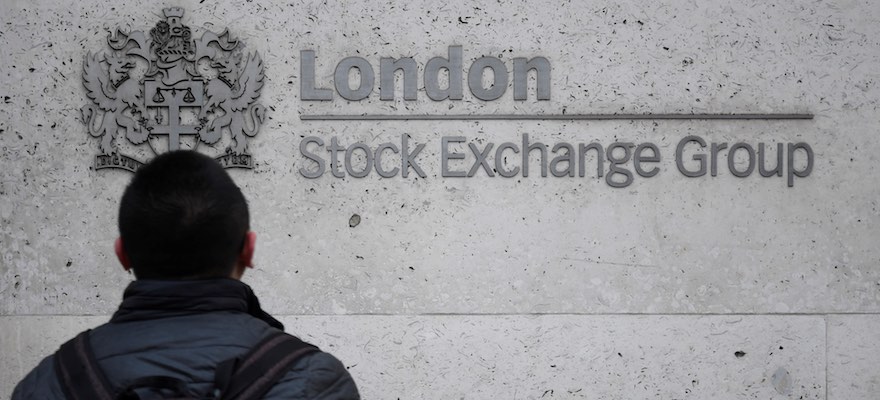For the first time since the Asian and Russian crises rocked world financial markets in the late 1990s, U.S. monetary policy is as focused on the risks to global growth as it is on the domestic economy.
Driving the resurgent internationalism inside the Federal Reserve is concern about how dollar strength -- reinforced by aggressive policy easing abroad -- could keep U.S. inflation too low when the Fed’s policy rate is close to zero. Another worry is a global economy that’s lumbering along without a prominent engine of growth, said Jon Faust, a former adviser to Fed Chair Janet Yellen.
“We have learned that the world is a more fragile place,” said Faust, who is now the director of the Center for Financial Economics at Johns Hopkins University in Baltimore. “At times like this, you don’t want to risk a significant slip because globally there are so few economies with really strong policy options.”
The Fed’s decision Wednesday to hold its benchmark rate target at 0.25 percent to 0.5 percent and lower the path of future hikes comes after global finance ministers and central bank governors agreed in Shanghai last month to use all policy tools to strengthen growth. Yellen and U.S. Treasury Secretary Jacob J. Lew were among the participants at the Group of 20 meeting.
The Federal Open Market Committee’s statement referred to global economic and financial developments twice, and Yellen opened her press conference with the phrase.
Core Inflation
Even with signs of life in U.S. core inflation measures and payroll gains averaging 235,000 over the past six months, Fed officials lowered their median estimate on how far interest rates would rise this year to just two hikes instead of the four they published in December.
“Their view is: worry about the rest of the world now, and then worry about U.S. inflation later,” said Torsten Slok, chief international economist at Deutsche Bank AG in New York. “Time will tell if that is an appropriate strategy.”
The less aggressive rate path comes amid rising expectations of additional easing by the Bank of Japan and more monetary stimulus put in place by the European Central Bank this month.
Fed Psyche
The moves by ECB President Mario Draghi and BOJ Governor Haruhiko Kuroda “have gotten deep into the psyche of Fed officials,” said Chris Rupkey, chief financial economist with Bank of Tokyo Mitsubishi UFJ Ltd. in New York. “The world’s problems are not over yet, and until someone upgrades the growth forecast, the already reluctant Fed is unlikely to strike out very far on its own.”
The new policy emphasis focuses on restrained divergence from other central banks and sensitivity to the risks policy actions could have on foreign economies and the U.S. through channels such as a strong currency, which can keep inflation too low and depress manufacturing and exports.
“They consistently tie back the international story to the U.S. economy and inflation,” said Luke Tilley, chief economist at Wilmington Trust Company in Delaware. “I think it is appropriate, but they are being quite risk-averse.”
Shanghai Pledges
David Lipton, the first deputy managing director of the International Monetary Fund, recently said it was time for policy makers to take action -- as they had pledged in Shanghai -- or risk a self-reinforcing cycle of retrenched capital spending, low productivity, deflation, and stagnant growth.
The global economy is at a “delicate juncture where the risk of derailment has grown,” he said in March 8 comments in Washington. Conditions have deteriorated in recent months. The IMF in January cut its world growth outlook to 3.4 percent, from 3.6 percent, as China’s economy cooled and slumping commodity prices pulled down the forecast for emerging market economies.
“We will use all policy tools -- monetary, fiscal and structural -- individually and collectively to achieve these goals,” G-20 officials said in their communique on Feb. 27. “Monetary policies will continue to support economic activity and ensure price stability, consistent with central banks’ mandates, but monetary policy alone cannot lead to balanced growth.”
In her press conference, Yellen didn’t spend a lot of time enumerating the risks to the global economy.
She talked about a “slight downgrading” of global growth forecasts. China’s slowdown “hasn’t proven a great surprise,” while China and Mexico are feeling the effects of lower oil prices, she noted. She also pointed out that the FOMC decided not to say that the risks to their outlook for the U.S. were weighted to the downside.
Balance of Risks
“The committee did not reach that judgment,” she said.
Taken together, however, the general slog of growth world-wide is why “a slightly lower path for the federal funds rate will be appropriate to achieve our objectives,” she said.
Her remarks may have understated what seems to be a strong consensus among FOMC participants that rates can’t rise too quickly.
Nine officials estimated two more rate hikes would be sufficient to achieve their forecasts this year. In December, only four officials penciled in two rate hikes for 2016.
A slower pace of Fed rate hikes is critical for emerging markets which are already struggling with low commodity prices and dollar-denominated corporate debt, said Michael Arone, chief investment strategist at State Street Global Advisors in Boston.
“Emerging markets make up 40 percent to 50 percent of global gross domestic product,” Arone said. Monetary policies can “buy time” for politicians to put in place fiscal and structural policies that can boost economic growth, he said. “The problem is that is not happening at a pace people would like.”
(Updates with comment from IMF's Lipton in 13th paragraph.)
--With assistance from Steve Matthews To contact the reporter on this story: Craig Torres in Washington at ctorres3@bloomberg.net. To contact the editors responsible for this story: Carlos Torres at ctorres2@bloomberg.net, Brendan Murray, Alister Bull
By: Craig Torres
©2016 Bloomberg News















